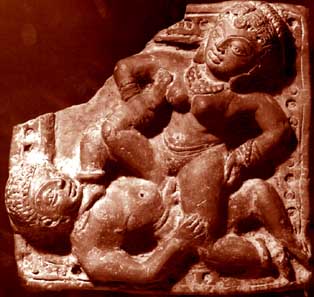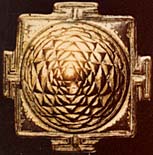|
(extracted from "Spiritual Sex: Tantric Software for Love",
|
Northern India. Circa 5th century. |
| VATSYAYANA'S CONTRIBUTION Vatsyayana's Kama Sutra is valuable today for his psychological insights into the interactions and scenarios of love, and for his structured approach to the many diverse situations he describes. He defines different types of men and women, matching what he terms "equal" unions, and gives detailed descriptions of many love-postures. The Kama Sutra was written for the wealthy male city-dweller. It is not, and was never intended to be, a lover's guide for the masses, nor is it a "Tantric love-manual." About three hundred years after the Kama Sutra became popular, some of the love-making positions described in it were reinterpreted in a Tantric way. Since Tantra is an all-encompassing sensual science, love-making positions are relevant to spiritual practice. Generally, Tantras only recommend the use of only a few different love-postures during spiritual sex sessions. Five principle positions, all of which are found in the Kama Sutra, cover what is normally appropriate. These five principle Tantric love-making positions (which have many variations) are: l) Man on his back, woman on top; 2) Woman on her back, man on top; 3) Woman and man on their sides, facing each other; 4) Woman with her back to the man; 5) Seated positions, normally face-to-face. Vatsyayana's Kama Sutra is divided into seven parts; general remarks, amorous advances, acquiring a wife, duties and privileges of a wife, relations with other men's wives, and a section about courtesans and occult means. The seventh and last part of the Kama Sutra is an appendix to the main work. It includes detailed formulations of substances familiar to Ayurvedic (Indian indigenous) medicine, with the emphasis on virilifics and aphrodisiacs. Some magical procedures of a type that in later times would be described as Tantric, are also found in the last chapter of the Kama Sutra. The terminology used by Vatsyayana is context specific. For example, when he uses the word Yoga he is referring to sexual intercourse, the word Tantra means to him "method," "technique," or "mechanics," and he uses the word Yantra to mean the sexual organ "utilized as an instrument," or to mean a dildo or "artificial love device." Lingam specifically refers to the male sex organ, while Yoni refers to the female sex organ. The Kama Sutra has hardly any resemblance to any known Tantra, nor do any Tantras resemble it, except in their common inclusion of brief descriptions of love postures. Nevertheless, the Kama Sutra is the earliest surviving sexual "how-to" and set the stage for many others, including those in which sexual techniques, postures, potions, charms and superstitions were promoted over the centuries. SIR RICHARD BURTON AND THE KAMA SHASTRA SOCIETY Sir Richard Francis Burton (1821-1890), the famous Victorian orientalist and traveler, kept an Indian girl as his mistress during his stay in India. Eventually he returned to England and in 1873, he and several friends founded the London Anthropological Society, issuing the periodical, Anthropologia. Concerning this, he wrote: My motive was to supply travelers with an organ that would rescue their observations from the outer darkness of manuscript and print their curious information on social and sexual matters. This periodical was instrumental in educating many Victorian persons of influence about the diversity of human sexual behavior. Later, Burton co-founded the Kama Shastra Society. This small and highly secretive organization privately published the Kama Sutra (in 1883) and the Ananga Ranga (in 1885), the first ancient Hindu treatises on the arts of love to be translated into the English language. Amazingly they could not be "officially" published in English until the mid 1960s, following a landmark court case. DR. ALEX COMFORT AND THE JOY OF SEX One of the ways that sexual barriers have been broken down in the West has been through the publication of sexual "how-to" books. Undoubtedly the most successful of all has been : THE JOY OF SEX a Gourmet guide to Love Making Alex Comfort's was not his first erotic work. In 1961 his Darwin and the Naked Lady In the introduction to his English version of the Koka Shastra, Dr. Comfort points out that India and most other cultures have a rich and refined erotic literature, whereas Judaeo-Christian culture does not. He writes: The Sanskrit textbooks on the art of love form a continuous sequence from remote antiquity to the sixteenth century AD. or later, and on to the present time in vernacular versions and inspirations. Most great cultures, as well as many tribal societies, have had a literature of this kind -- our own Judaeo-Christian tradition is almost unique in lacking one. Dr. Comfort then explains how, because of Western culture's fear and rejection of sexuality, persons interested in sexual topics had either to turn to the classics of antiquity or to certain ecclesiastical or medical writings. Alex Comfort's The New Joy of Sex |
|

